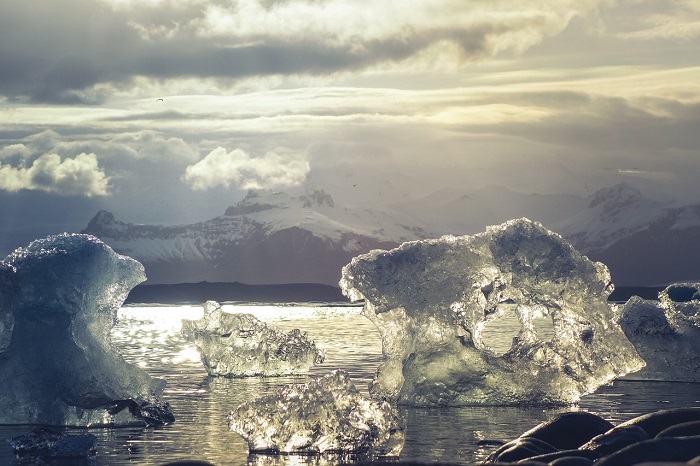
One of the scientific mysteries of Antarctica are its 379 lakes hidden below the continental glacier, including the largest and best known Lake Vostok, situated below the Russian research station of the same name. We asked Dr Maciej Kania from the JU Institute of Geological Sciences to reveal some of these mysteries.
The first mentions of an enormous lake in the Antarctic (Lake Vostok is the seventh biggest lake in the world by volume and fourth by depth) surfaced in 1996, although people suspected that there might be a large ice-covered body of water near the Sovietskaya research station as early as the 1960s and 1970s. The lake’s existence was proven through the use of 60 MHz radio waves. Putting it simply, scientists used a radar to scan the glacier – electromagnetic field of that frequency passes through both solid and liquid water. In time, we have acquired more and more information about this and other such lakes. For instance, it turns out that the changes in levels of water in subglacial lakes are mirrored by height of the icy surface. We know this thanks to a technique called ‘satellite altimetry’. The shape of the lake, on the other hand, was determined via seismic profiling. The method is based on emitting seismic waves and then registering their echoes coming back from various discontinuities (i.e. surfaces that mark a change in physical or chemical characteristics of rock or ice masses). Lake Vostok is 344 metres deep on average, with the deepest spot located at 870 metres.
The water surface of Lake Vostok lies four kilometres under the ice. It looks like a giant spindle, measuring about 250 by 50 kilometres. This shape is directly related to the geological structure of Eastern Antarctica. Lake Vostok is a tectonic lake, much like Lake Baikal in Syberia. The lake lies within an 80-kilometre deep rift in the Earth’s crust, as evidenced by geophysical research. It’s universally assumed that it’s a part of the intercontinental rift zone, long since inactive. But is that the truth?
Echoes from the deep

Lake Vostok is the largest freshwater lake in Antarctica. Twenty million years ago, a thick layer of ice separated it from Earth’s atmosphere and hydrosphere. Its waters are probably not that old, since the lake is a part of an active subglacial hydrologic system. It’s estimated it would take 250,000 years to entirely replace the waters of the lake. However, to analyse these waters is no easy task. Not only is it necessary to drill through four kilometres of ice, but also to do it in such a way that the lake does not become contaminated (mostly by organic substances coming from the surface in the drilling fluid used to keep the drill cool, carry out drill cuttings, suspend the drill, and so on). Another important factor is that the lake is located in the Pole of Cold region, which makes the ice even harder to drill in. It took Russian scientists 15 years to get through the glacier.
They finally reached it in 2012. The waters of the lake, being under significant pressure, quickly shot up the borehole, pushing out the specially prepared light drilling fluid, and then rapidly froze, creating a ‘cork’ of sorts that protected the lake from contamination. It was this cork – an ice core – that was later studied to determine the properties of the water. Although the entire operation was carefully planned, there have been some criticisms concerning possible contamination.
A British research team used a different approach when they attempted to drill into another subglacial lake, Lake Ellsworth – they used pressurised sterile hot water. However, they abandoned their project due to technical difficulties.
Unknown life
Shortly after the water samples from Lake Vostok were collected, the scientists announced that they contain bacteria with an unknown sequence of DNA. Preliminary results have shown that these bacteria were unlike any microorganisms suspected of contaminating the lake. Although it seemed quite extraordinary at first, it quickly became clear that although the bacteria were indeed unknown, there was a possibility that they entered the lake with the drilling liquid. We can only hope that studying another ice core sample, taken in 2015, will bring some more definitive results. Both scientists and engineers claim that the safety precautions they employed were even greater than in 2012.
The half-litre sample of the lake’s waters contained 3,507 unique genetic sequences, which enabled the researchers to identify and classify 1,623 organisms.
In 2013, U.S. biologists have published the results of their research on samples of Lake Vostok’s accretion ice. This type of ice accumulated at the rate of 3 metres per year at the base of the glacier and above the lake. The half-litre sample of the lake’s waters contained 3,507 unique genetic sequences, which enabled the researchers to identify and classify 1,623 organisms. Out of these organisms, 94% were bacteria, 6% were eukaryotes, while two sequences were classified as Archaea. The genotypes found were typical of extremophiles – organisms that thrive in environments characterised by extreme temperatures, pressure, salinity etc. Researchers discovered thermophiles and cryophiles (organisms living in very hot or very cold temperatures), halophiles (organisms preferring high salinity), and other microorganisms which require high acidity or alkalinity.
The existence of such a complex ecosystem in Lake Vostok is a surprising discovery. The presence of thermophiles suggests the possibility of hydrothermal vents near the bottom of the lake, which in turn could mean that the rift zone isn’t entirely inactive. The results of the research are interesting for astrobiologists as well, since subglacial ocean is most probably located on one of Jupiter’s moons, Europa, and possibly on some of Saturn’s satellites too.
Photograph under the title: ice cores extracted near Vostok Station. Licence: Public Domain.
Original text: www.nauka.uj.edu.pl
Bibliography:
- Brahic, C. Subglacial Lake Vostok cracked for a second time. www.newscientist.com/article/dn26907-subglacial-lake-vostok-cracked-for-a-second-time/
- Kaufman, M. Breaking through the ice at Lake Vostok. www.astrobio.net/extreme-life/breaking-through-the-ice-at-lake-vostok/
- Kędzierski, Mariusz (JU Institute of Geological Sciences) – kalcyt.blogspot.com, entries: kalcyt.blogspot.com/2012/02/rosjanie-potwierdzili-vostok-osiagniety.html and kalcyt.blogspot.com/2012/02/vostok-blisko-coraz-blizej.html
- Leonov, V., Popov, S. Geological Structure of Central East Antarctica from Geophysical Data. Geotectonics, 2009, Vol. 43, No. 4, pp. 274–282
- Shtarkman, Y. et al., Subglacial Lake Vostok (Antarctica) Accretion Ice Contains a Diverse Set of sequences from Aquatic, Marine and Sediment-Inhabiting Bacteria and Eukarya. PLOS One, 2013, 8: e67221
- Studinger, M. et al.. Ice cover, landscape setting, and geological framework of Lake Vostok, East Antarctica. Earth and Planetary Science Letters 205 (2003) 195-21
- Wright, A. & Siegert, M. The Identification and Physiographical Setting of Antarctic Subglacial Lakes: An Update Based on Recent Discoveries, Antarctic Subglacial Aquatic Environments. 2011, Geophysical Monograph Series 192





